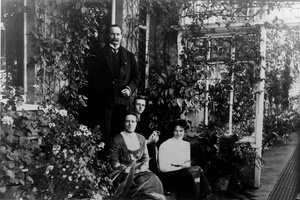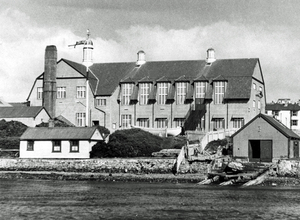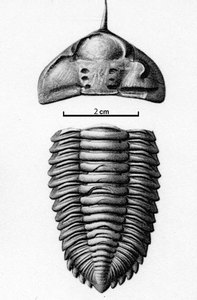ALLARDYCE, Lady CONSTANCE ANGEL
1861-1919 from Australia
palaeontologist, was born Constance Angel Green in Victoria, Australia, on 23 December 1861.
She married William Lamond ALLARDYCE in 1895 whilst he was serving as a British government official in Fiji, and their two daughters (Viti and Keva) were born there. Constance and her husband were instrumental in establishing the Fijian national museum, and brought the same philosophy to the Falkland Islands when William was appointed governor in 1904. One of their initiatives was the construction of a new Town Hall in Stanley, and Constance Allardyce is credited with ensuring that the building contained facilities for a library and a museum.
Constance took a keen interest in geology and natural history, and encouraged a search for curios throughout the Falkland Islands. One happy outcome of this was the discovery by members of the McAskill family, during the 1908-1909 austral summer, of a remarkable fossil bed on Pebble Island, just off the north coast of West Falkland. Fossils of Devonian age had first been found on the Falklands, at Port Louis in East Falkland by Charles DARWIN during the visit of HMS Beagle in 1833. Since then, despite collections being made from additional fossil-bearing localities by various explorers, most notably two Swedish geologists, JG ANDERSSON and TG HALLE, nothing of substance had been added to the range of species described by Darwin. Constance Allardyce’s work with the far superior Pebble Island fossil specimens would soon change that.
The similarity of the Falkland Islands’ Devonian fauna to that of South Africa and South America as already known, and utilising the well-preserved fossils from Pebble Island, Constance embarked on scientific collaborations with palaeontologists working in those areas. For South Africa, she exchanged information and specimens with Ernest HL Schwarz, who acknowledged her contribution in his book Causal Geology published in 1910.
A more extensive collaboration was developed with John Clarke, an eminent American palaeontologist then studying the Devonian fauna of Brazil and Bolivia. Clarke made a detailed analysis of the fossils prepared and tentatively identified by Constance Allardyce, and incorporated descriptions and illustrations in his extensive (and bilingual) monograph Fosseis Devonianos do Paraná, published in 1913 by the Serviço Geológico y Mineralógico do Brasil. Therein, Clarke lists 22 species identified from the Allardyce material, including trilobites, brachiopods, bivalves, gastropods, crinoids and orthocones. Clarke’s monograph, which also considered specimens collected by Andersson and Halle, remains the definitive account of the Devonian palaeontology of the Falkland Islands.
As a mark of his appreciation, Clarke coined the name Cryphaeus allardyceae for one of the new species of trilobite that he had discovered amongst the Pebble Island specimens, and wrote in his Brazilian report: “Named in appreciation of the aid rendered to these studies by Mrs Constance A. Allardyce of Port Stanley.” He also remembered her husband with the gastropod Diaphorostoma allardycei. More recent research has subdivided the genus Cryphaeus, so that Mrs Allardyce’s trilobite is now known as Metacryphaeus allardyceae. The acknowledgements in Clarke’s report conclude:
“The contributions made by Mrs Allardyce have been of moment and … I take an especial pleasure in giving this public testimony to the worth of [her] assistance.”
There has been some confusion over the naming of the Allardyces’ fossils, so, to be clear: Metacryphaeus allardyceae is Constance Allardyce’s trilobite; Diaphorostoma allardycei is William Allardyce’s gastropod.
In 1915 Constance Allardyce left the Falkland Islands when her husband William was appointed governor of the Bahamas. William was knighted in 1916 and so for a short while, until her untimely death in Nassau on 23 November 1919, Constance became Lady Allardyce. Prior to that she had been active in war work and was one of the first recipients of the OBE. Her obituary in the Nassau Guardian (26 November 1919) noted that she “excelled as a horsewoman and an all-round athlete”. Another obituary, written by her scientific collaborator John Clarke (by then Director of the New York State Museum), appeared in the prestigious international scientific journal Science on December 26, 1919. It reads, in part, as follows:
The name of Constance Allardyce, wife of Sir William Allardyce … will not go unrecorded in the annals of science…. The writer gratefully recalls her enthusiastic aid in assembling the fossils of the rich and remarkable Devonian fauna of the [Falkland] islands …. the collections gathered by Mrs Allardyce are the basis of pretty much all that we know today of the ancient life of those islands and her name and services have been permanently interwoven in the geological story of the Falkland Islands.
External links
References
Clarke, J. M. 1913. Fósseis Devonianos do Paraná. Monographia do Serviço Geológico y Mineralógico do Brasil, No 1, page 114 and plate 4 (figures 7 and 8).
Stone, P. 2009. Mrs Allardyce and the trilobite. Falkland Islands Journal, 9 (3), 9-16. http://nora.nerc.ac.uk/id/eprint/8815/
Comments
Fiona Keva Butler Ferguson
2024-08-08 23:21:48 UTC
Wow! I didn't know any of this. Constance Allardyce was my great grandmother! Her daughter Keva, was my grand mother and Fairlie, her daughter is my mother. She turned 90 this year in May.
Apologies if this is not the place to express such a connection! It was lovely finding this article however. Thank you.
Revisions
2017 - Original version
2018 - Text corrected
June 2019 Illustration and references added
February 2020 One external link added; two additional photographs added



